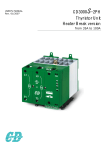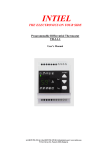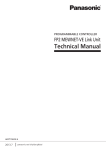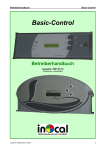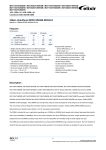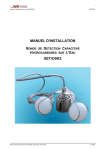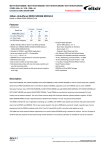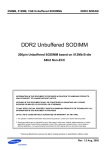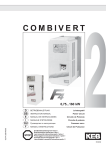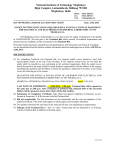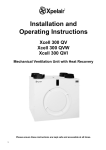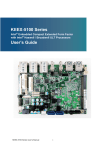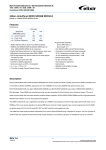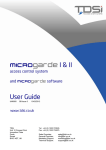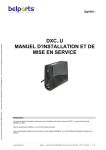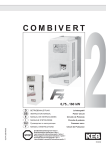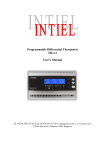Download Technician manual
Transcript
Technician manual lambda control Issue: 2001-05-22 translated 2009 The uncompromising and most economic solution for our customers Active combustion air regulation with O2 sensor Modulating operating Integrated return high posture Integrated buffer charge regulation Certificated by the guidelines of the EU Multifunctional system application Logotherm Regelsysteme GmbH Writer: Werner Atzenhofer Translator: Roland Brantner 1 INDEX Short description of the controller “lambda control” ...................................................................................... 3 Display- and control elements...................................................................................................................... 4 Display- and control elements...................................................................................................................... 5 Output regulation ......................................................................................................................................... 6 Return valve regulation system 1 to 4.......................................................................................................... 7 Loading valve regulation system 3 and 4 ..................................................................................................... 8 Return- and loading valve regulation system 5............................................................................................. 9 Return- and loading valve regulation system 5............................................................................................10 Enlarged application System 5 with oil-/gas boiler.......................................................................................11 Enlarged application System 5 with oil-/gas boiler.......................................................................................12 Enlarged application System 5 with oil-/gas boiler.......................................................................................13 System 5 / technician menu Code +1..........................................................................................................14 Output regulation summary.........................................................................................................................15 O2 sensor ...................................................................................................................................................16 1. O2- regulation..................................................................................................................................16 2. Function monitoring in the heating operation....................................................................................16 3. Automatic calibration and functional test ..........................................................................................16 4. Manual calibration and functional test ..............................................................................................16 O2 sensor ...................................................................................................................................................17 5. Shut-off criteria (Heat generation OFF)............................................................................................17 6. Life span of the oxygen probe ..........................................................................................................17 7. Possible causes by faults .................................................................................................................17 8. Marking of the connection wires.......................................................................................................17 O2 sensor summary ....................................................................................................................................18 Chimney-sweep's test: Nominal power/ partial-load/ security test ................................................................19 Door opening-refueling/ auto. start-up/ exhaust temperature too high .........................................................20 Service code / Code +1 ..............................................................................................................................21 Service code / Code +1 / Code -1 ...............................................................................................................22 Protective functions / aggregate test ...........................................................................................................23 Security functions / controller test/ PATENT ...............................................................................................24 Technical data / settings .............................................................................................................................25 Technical data / connection plan.................................................................................................................26 Advantages with lambda control .................................................................................................................27 INTRODUCTION PROTOCOL ...................................................................................................................28 FAULTS .....................................................................................................................................................29 FAULTS .....................................................................................................................................................30 FAULTS .....................................................................................................................................................31 Service code / Code -2 (Par. 14 – 16).........................................................................................................32 Service code / Code -2 (Par. 17 – 21).........................................................................................................33 Service code / Code -2 (Par. 22 – 28).........................................................................................................34 SYSTEM 1: Monovalent system with custom water tank .............................................................................35 SYSTEM 2: Bivalent system with custom water tank ..................................................................................36 SYSTEM 3: Mono- or bivalent system with buffer and loading valve...........................................................37 SYSTEM 4: Mono- or bivalent system with buffer and loading valve...........................................................38 SYSTEM 5: Mono- or bivalent system with buffer .......................................................................................39 2 Short description of the controller “lambda control” Active combustion air regulation for the optimization of the emissions values with different fuel qualities and different moisture Sensors: Boiler-, exhaust- and buffer- or return sensor / O2 sensor Integrated return high posture and buffer charge regulation Integrated operating continuation by combination with oil-/gas boiler Automatic speed change-over, depending on the boiler output-related power by 2-step exhaust fan Modulating operation by motor regulated primary- and secondary air Assistance of the chimney-sweep by own test function: Nominal power or partial load for emission test and security test for the checking of the STB and the thermal expiry protection Protective functions for boiler and aggregates at close-down (summer) Function protection against frost if the boiler temperature is less than 5ƒC An easy service with text display Refueling signal at the controller and as a remote indication possibly Service program for introduction and servicing Automatically activated alternative programs by any faults Fault indication in plaintext Text display into several languages Storage space for specific characteristics of the different boiler types Programmable for different system applications Made and checked by the guidelines of the EU SYSTEM 1: Monovalent system with or without process water tank Regulation of the process water temperature by lambda control Heating regulation: By hand or automatically with minimum heat consumption Heating release (heating pumps) by lambda control Winter or summer function selectable by the customer SYSTEM 2: Bivalent system with or without process water tank Regulation of the process water temperature by lambda control or by regulation of the oil-/gas boiler Heating regulation by oil-/gas boiler with minimum heat consumption Compulsive warmth decrease before the boiler is switching to readiness Automatic operating continuation at alternative operating method SYSTEM 3 and 4: Mono- or bivalent system with buffer and loading valve Dimensioning of the boiler output according to warm need calculation Heating precedence (starting-up discharge by switching off the buffer) Intelligent buffer management after a Logotherm PATENT (buffer charge priority depending on boiler temperature set value) Rest warmth denial to boiler minimum temperature (difference regulation) Refueling signal at under-usage of the buffer minimum temperature SYSTEM 5: Mono- or bivalent system with buffer (loading valve optional) Steady temperature load by regulated return temperature of the wood boiler Regulation of the return temperature of an oil-/gas boiler by bivalent systems with automatic operating continuation All buffer connection variations Rest warmth denial to boiler minimum temperature Refueling signal after burn-out of the boiler (automatic operating continuation) Additional function with loading valve Dimensioning of the boiler output according to warm need calculation Heating precedence (starting-up discharge by switching off the buffer) Intelligent buffer management after a Logotherm PATENT (buffer charge priority depending on boiler temperature set value) 3 Display- and control elements lambda control + - ! m ade by logotherm 1 2 3 “Heat generationugung ON” EIN “ 1 Display An zei ge " W „rmeerze “Refuelling” 2 Display An zei ge " Na chle gen“ 3 Display “Fault” 3 An zei ge " St… rung“ 4 Text display 4 Textan zeig e 4 5 6 7 8 9 5 Button generation ON /EIN +” / Plus “ Taste “Heat "W „ rmee rzeug ung 6 generation OFF AUS / -” / Min us" 6 Button Taste “Heat "W „ rmee rzeug ung 7 ” 7 Button Taste “"P feil" 8 Button “Refuelling” 8 Taste "Nachlege n“ 9 Reset button of the safety temperature 9 Wie dereinscha ltknopf des limiter (STB) Sich erheitstemperaturbe grenzers (S TB ) Display “Heat generation ON” Shines, if the combustion expiry is start-up by - pushing the button “Heat generation ON”, or automatically - if the exhaust temperature is enough. Goes out, if the combustion expiry is stopped by - pushing the button “Heat generation OFF”, or automatically - if the fuel material is used up. Display “Refueling” Shines, if - the heat generation was switched off and - the warm need of the system renewed refueling required or allowed. Flashes, during the function “Refueling”. Goes out if the warm production is switched on. Display “Fault” Shines if faults appear which do not allow a continuation of the warm production, or the turning on of the warm production. Flashes if faults appear which allow a continuation of the warm production, or the turning on of the warm production. (Control after alternative program up to disturbance removal) Goes out if the faults were repaired and were reset. Text display Switched ON , - in the operation state “Heat generation ON” or - in the operation state “Heat generation OFF” by pushing a button. Switched OFF, - in the operation state “Heat generation OFF” and after the expiration of 15 minutes. 4 Display- and control elements Button “Heat generation ON / +” Function level 1: By pressure of the button, warm production becomes the operation state ON. Function level 2: By pressure of the button - functions can be selected or - settings can be changed. Button “Heat generation OFF / −” Function level 1: By pressure of the button, - warm production becomes the operation state OFF or - the function “Refueling” will be prematurely cancelled. Function level 2: By pressure of the button, - functions can be selected or - settings can be changed. Button “ ” By pressure of the button occurs - the entrance in the choice menu and - the switchover to the function level 2. By renewed pressure of the button occurs the confirmation of - the selected functions or - the changed settings. Button “Refueling” By pressure of the button occurs - the start-up of the exhaust fan in the high speed and - after 15 sec. the enabling of the electromagnetic door opener for 10 sec. (After the expiration of 10 minutes the automatic cancelling of the function “Refueling” occurs) Reset button of the safety temperature limiter (STB) If the STB has released as a result of a too high boiler temperature, and has dropped afterwards the boiler temperature on approx. 80ƒC, is by pressure of the button - the STB reset and - the fault is automatically receipted. 5 Output regulation The divergence of the boiler temperature-actual value TB act. and the boiler temperature-set value TB set becomes, taking into account the minimum and maximum exhaust temperature, moved in a combustion air amount (motor steered air flaps in 200 steps). The controller automatically selects, according to power requirement, the necessary fan step. TB act. < TB set minus 2ƒC = speed level 2 TB act. > TB set plus 2ƒC = speed level 1 If the boiler temperature TB act. is smaller than the boiler temperature set value TB S. the power can be raised up to at most allowed exhaust temperature Tfl. If TB I rises about TB S, the boiler power can be reduced up to minimally allowed Tfl. The minimum exhaust temperature is that, for the chimney needed, least exhaust temperature Tflmin. With system 3 to 5 the controller follows, in addition, the exhaust temperature for checked partial load TARmin. If the exhaust temperature is bigger for partial load than Tflmin, this is kept up to a boiler temperature from 86ƒC. If the boiler temperature is > 86ƒC, it is also regulated with system 3 to 5 on Tflmin. This allows in the released exhaust temperature area the boiler temperature and with it the power consistently to hold. If a boiler temperature from 88‚C is reached (achievement decrease below the necessary exhaust temperature) the controller switches off the fan (Readiness). The primary air flap is put on least opening, the O2 regulation works after standard program. If the boiler temperature rises on 90‚C, both flaps are closed. If the boiler temperature sinks on 87.5‚C, the exhaust fan is switched on and the secondary air flap open for one minute to ventilate the chimney. lambda control Modulating operation TAR [‚C] 260 180 240 160 220 140 200 120 180 100 160 80 140 120 100 80 60 40 20 0 TARmax PB [%] Modulating operation TARmin TB>86‚C Sys. 3 - 5 Tflmin TB>88‚C Readin.* 125 100 Released field of work 200 Tflmin 90-160ƒC 280 60 40 50 20 25 0-10 0 TK = 80ƒC Tfl [‚C] TB<TB S TB = TB S TB>TB S TB>TB S TB>TB S Beispiel: TB Set=80 / TARmax=160 TARmin=40 / Tflmin=100 *Readiness 6 Return valve regulation system 1 to 4 1. Return valve regulation system 1 to 4 Task of the return valve: Return high posture (Boiler protection function). A high quantity of water is made available very quickly by the automatic band width regulation of the return valve for the system heating. To receive this function with system 3 and 4, a loading valve must be used (heating starting-up discharge by disconnection of the buffer). Example Example with withTB-Set TK-Setvalue value85‚C 85‚C Band width of the return valve after the first hour (the reduction of the band width occurs gliding) 0% 100% 55 60 65 70 75 80 85 90 TB TK act. I [ƒC] [ƒC] TK-Set value–- adjustment adjustmentrange range TB-Set value 0% 100% atTB-Set TK-Setvalue valueminus minus2ƒC 2ƒC 100% -- at Band width of the return valve in the first hour Advantages of the engine-steered return valve Return high posture - Boiler protection Prevention of the clocking of the heat extraction with cold heating system Prevention of the gravitation circulation after burn-out with loaded buffer Rest warmth use also at boiler temperatures <60ƒC 7 Loading valve regulation system 3 and 4 2. Loading valve regulation System 3 and 4 Effect of the TB-set setting to the boiler- and loading output Example 1: TB-set setting 70‚C causes a buffer load with boiler partial load and only with the difference boiler partial load minus warm need Operating range: Small Buffer volume (Load balance memory) Low temperature heating Solar-integration into the buffer The boiler temperature is regulated on 70‚C, at exhaust temperature area TARmax = maximal output and TARmin = Partial load, (modulating operation). If less output is required than with TARmin (partial load) is generated, the boiler temperature rises over 70‚C. From 72ƒC the loading valve is opened proportionally to the boiler temperature and the overrun output (partial load minus warm need) is stored in the buffer. Example 2: TB set setting 80‚C causes a buffer load after starting-up discharge with raised loading output Operating range: Buffer volumes enough for the admission of a complete fuel charge Thermal buffering is volitional (loaded buffer) By the TB-set setting 80‚C the regulator has the ambition to reach this temperature. If the boiler temperature is less than 80‚C the regulator raises the output to TARmax. While crossing from 72ƒC (starting-up discharge finished) the loading valve opens proportionally to the boiler temperature and loads the boiler by which this works furthermore on higher output. The actual boiler output and boiler temperature is depending on warm need of the heating and the temperature of the buffer. If the boiler temperature rises above TB-set, the boiler is steered on partial load, the loading valve is further opened and the buffer is further loaded. By reduced boiler output the difference is reduced (boiler flow to return) and the buffer can be still raised 2 times about per 4‚C, without the regulator switches in readiness (88ƒC = readiness). Boiler set values ≤80‚C results lowest standby time. By the loading valve function you have the following vantages; Heating starting-up discharge closed by loading valve under 72‚C (Boiler output must not become oversized) Automatic adaptation of the loading output with rest warmth in the buffer by loading valve - band width regulation Free selectable supercharging rate by TB-set setting and output regulation to TB-set respectively loading capacity value Loading valve position in dependence of the boiler temperature-actual value TB act. <= 72ƒC Loading valve 0% = Return buffer upside TB act. = 78ƒC Loading valve 50% = Return buffer at the bottom opened with 50% TB act. >= 84ƒC Loading valve 100% = Return buffer at the bottom opened with 100% Load valve: System 3 and 4 0% 55 60 65 70 100% 75 80 85 90 TB [ƒC] TK act. I [ƒC] 72ƒC 84ƒC Band width of the load valve 8 Return- and loading valve regulation system 5 Constant boiler flow temperature by constant return temperature A constant boiler flow temperature is due to the constant return temperature. The return valve is regulated regardless of the return temperature TR by the buffer system and heating system on the return set value TR S. The delivered quantity of water to the buffer system and heating system is calculated after the formula: Litre = 860 x kW / Difference. In this case the difference is measured between the boiler flow and the return from the buffer system and heating system. Remark: The heating flow temperature can be smaller than the boiler flow temperature if the delivered boiler amount of water is smaller than the heating flow amount. For example: Buffer cold / Heat consumption greater than boiler output. 1. Gliding return set value by boiler temperature set value minus difference The difference is measured between the boiler flow and the boiler return. It follows from the boiler output kW and the flow amount L of the primary pump M1! Difference = kW / L x 860 (adjustable between 5ƒC and 15ƒC. The standard value is 10ƒC). The flow amount is calculated after the formula: Litre = 860 x kW / Difference Calculation example of the dimensioning of the primary pump M1: Boiler actual power output = 30kW Difference = 10ƒC L = 860 x 30 / 10 The required flow amount is searched L = 2580 (Discharge flow of the Primary pump M1) Function: The return temperature is regulated by means of return sensor and return valve on the return set value TR S. The return temperature set value is due to automatically by the boiler temperature set value TB S. minus the adjusted difference. Example: TK Set = 80ƒC Difference = 10K Effect: Return set value = 70ƒC lambda control calculates automatically the new TR Set value at TK-Set value changing 2. Gliding loading valve set value by TB set minus difference Function: The load of the buffer occurs only if the return valve is opened on 100%, this equates “Heating starting-up discharge completed – buffer up-side warm”. Now Lambda control calculates the return set value TR S. for the loading valve as a function of TB S. The loading valve set value is calculated as follows: TR set = TK set - (TK set – 70) (15 / Difference) lambda control calculates automatically the new TR Set value at TK-Set value changing 9 Return- and loading valve regulation system 5 With the following examples it is supposed that the primary pump M1 is dimensioned for a difference from 10‚C (Kelvin) with a boiler maximum output of 125% = 37.5 kW. Example 1: TB-Set value 85‚C Effect: Return valve set value = 75ƒC Difference 10ƒC Loading valve set value = 75ƒC Boiler partial load 15kW The difference is unchanged! Boiler nominal output 30kW Boiler maximum output 37.5kW With TB Set setting 85‚C the return valve set value equals the Loading valve set value and the boiler output is not reduced. Loading output = Boiler output (ca. 37kW) minus warm need That is only heating starting-up discharge, no intelligent buffer management! Only recommend with high warm need and sufficient buffer volume. Comment: If the buffer is loaded (return 85‚C) it is required for the boiler part load a difference from 4ƒC, this proves a boiler temperature from 89‚C = Readiness! Example 2: TB-Set value 80‚C Difference 10ƒC Effect: Return valve set value = 70ƒC Boiler partial load 15kW Loading valve set value = 73.33ƒC Boiler nominal output 30kW The difference is reduced to 6.66ƒC Boiler maximum output 37.5kW Because the flow amount is unchanged the boiler temperature will rise over the TB-Set value and the controller reduces the boiler output to ca. 25 kW. After the system heating-up with boiler maximum output the boiler output is reduced. Loading output = Boiler output minus warm need. (Highest efficiencies by reducing exhaust losses). The heating starting-up discharge and the intelligent buffer management will be used! Recommended setting for systems with standard-buffer volume which should be also loaded. Comment: If the buffer is loaded (return 80ƒC) it is required for the boiler part load a difference from 4ƒC, this proves a boiler temperature from 84ƒC = the whole buffer can be raised for 2 times at 4‚C (TB act. > 88ƒC = Readiness)! Boiler set values ≤ 80‚C prove the lowest readiness times. Example 3: TB-Set value 75‚C Difference 10ƒC Effect: Return valve set value = 65ƒC Loading valve set value = 71.66ƒC Boiler partial load 15kW The difference is reduced to 3.33ƒC Boiler nominal output 30kW Boiler maximum output 37.5kW Because the flow amount is unchanged the boiler temperature will rise over the TB-Set value and the controller reduces the boiler output to ca. 12.5kW. However, this is not permitted by the boiler parameter for checked partial load, by which the controller holds the boiler output on ca. 15 kW (partial load). Loading output = Boiler output minus warm need. Thereby rises the boiler temperature on 75.66‚C. This means, the required difference from 4ƒC for 15 kW, result automatically from the boiler output. Comment: After the system heating-up with boiler maximum output, is the buffer loaded with boiler partial load (Highest efficiencies by reducing exhaust losses). Heating starting-up discharge and the intelligent buffer management are used! Recommended for low temperature heating systems or by integrated solar in the buffer. Miscellaneous: Return temperature sensor (Pt100 surface-contacting temperature sensor) instead of an sleeve sensor Rest warmth denial to boiler minimum temperature Refueling signal after burn-off of the boiler (automatic operating continuation) Loading valve position at warm production-OFF to buffer ON At an return sensor defect, the return- and loading valve regulation is activated at system 3 and 4 as an emergency program 10 Enlarged application System 5 with oil-/gas boiler Principle diagram: System 5: Flow temperature >75ƒC with 100% of warm required. Boiler output: Can be as high as the warm need, by loading valve Y2. Nevertheless, the buffer is not loaded with 100% of warm need, except with boilers with output reserve or Pk > Qh. Buffer: See boiler- and buffer dimensioning program. Processing water production in summer: With wood- or oil-/ gas boiler. A high efficiency is reached by the integrated Processing water accumulator, because no additional radiate- and transmission losses originate. H1 Remote indication refueling lambda control regulates the return temperature of the wood boiler and the oil or gas boiler Processing water accumulator Thermostat T1 Oil - Gas ON Thermostat T2 Oil -Gas OFF Woodboiler Oil- or Gas boiler Heating circuit Buffer Y3 RF M1 Y1 Y2 Wiring diagram: System 5 - two condition Normally open contact AK 2 L Normally closed contact RK 3 WK 1 L L1 Primary pump 12 *S1 T *S2 Root contact L - Electric supply L – Primary pump 3 1K1 4 1 1K1 2 T Primary pump N PE M1 0 2 T2 (Oil - Gas OFF) opens over 60ƒC 102 L M 1 1S2 T Controller: lambda control T1 (Oil - Gas ON) opens over 55ƒC Y1 L H1 Fernanzeige- N Nachlegen T Safety thermostat T Adjust thermostat Y2 M 1S1 5 1K1 6 Actuator N PE Change-over valve Y3 A2 1K1 A1 M Burner Oil- or Gas boiler N/230V PE S1 ... Exhaust temperature monitor S2 ... Door switch T1 ... Thermostat Oil - Gas ON T2 ... Thermostat Oil - Gas OFF 1S1 ... Switch 1 - 0 - 2 1 = automatic operating continuation 0 = Oil – Gas boiler OFF 2 = Oil – Gas boiler manual mode Y3 ... Change-over valve : L at Y1 = Position on wood heating L at Y2 = Position on Oil – Gas operating * ... At operation to one chimney must be mounted in the wood boiler a checked exhaust temperature guard (German Institute for Standardization 3440), a switch at the doors and be integrated into the control chain of the oil-/ gas boiler. 11 Enlarged application System 5 with oil-/gas boiler Function: After burn-out of the wood boiler, regulates lambda control the return temperature of the oil-/gas boiler by means of return sensor and return valve Y1. The return is switched by means of change-over contact (C/O contact) and the 3-way valve Y3 between wood boiler and the oil-/gas boiler. Two thermostats in the buffer switch ON or OFF the oil-/gas boiler and the primary pump M1. A maximum life span is reached by the return high posture of the oil-/gas boiler. A pollutant reduction by burner runtime lengthening is likewise reached. Release of the enlarged system application 5 with oil-/gas boiler in the basic level (The enlarged application is basically blocked by Logotherm!) • With menu CHOICE appeal • With +- Settings choose and with confirm • Service code call with + • 2-times input code +2 (basic level) 1. TEXT Oil-Gas boiler NO + YES 2. TEXT System minimal 3 + With +- YES choose and with confirm [Now the application is released in the expert's menu] With +- System minimal limitation choose and with confirm [e.g. 3 unblock in the expert's menu System 3 to 5] [e.g. 1 unblock in the expert's menu System 1 to 5] If no change is wished, with confirm After the confirmation the regulator returns in the operating program REMARKS to 1 and 2: 1. Boiler manufacturers which these applications do not need must not change by the basic barrier their documentation (lambda control requests for no enlarged input in the expert's menu). The application can be released any time boiler manufacturer covered by Logotherm, the release is thereby unnecessary in the basic level. 2. Kettle manufacturers the only system 3 to 5 has released can thereby release in the special case also the system application 1 and 2. 12 Enlarged application System 5 with oil-/gas boiler Inputs in the expert's menu if the application in the basic level (code +2) is released • With menu CHOICE appeal • With +- Settings choose and with confirm • Service code call with + • Input code +1 (Technician) After the loading valve-setting the additional input occurs 1. TEXT Oil-Gas boiler NO + With +- YES choose and with confirm If NO is selected, the expert's menu is finished and the opposed parameters are stored. The enlarged application is not activated. 2. TEXT Return temp. Oil-Gas [ÄC] + With +- Return temperature set value for Oil-Gas adjust and with confirm (Setting range 30ƒC to 80ƒC) After confirm with the expert's menu is finished and the opposed parameters are stored. Now the enlarged application is activated. Functional difference by mono- or bivalent arrangement 1.1 Rest warmth use without oil-/gas boiler (Monovalent): a, lambda control uses the rest warmth immediately after switch over in warm production OFF b, lambda control uses the rest warmth by a dynamic cycle up to 6 hours c, lambda control uses the rest warmth statically if the boiler temperature rises on 90ƒC 1.2 Rest warmth use with oil-/gas boiler (Bivalent): a, lambda control uses the rest warmth immediately after switch over in warm production OFF c, lambda control uses the rest warmth statically if the boiler temperature rises on 90ƒC b, Dynamic use is not carried out because of too frequent burner interruption Functional description of the rest warmth use after boiler burnout a, lambda control uses the rest warmth immediately after switch over in warm production OFF. If the boiler temperature is higher than TBmin and the difference boiler flow to boiler return is higher 5‚C, the rest warmth is delivered to the buffer- and heating system. If the difference is smaller than 4‚C or the boiler temperature smaller than TBmin, the rest warmth use is broken off (primary pump OFF - return valve CLOSED). The boiler minimum temperature TBmin is adjustable in the expert's menu. b, lambda control uses the rest warmth in the boiler by a dynamic cycle up to 6 hours. If the boiler temperature is higher than TBmin and is the time after switch over in warm production OFF smaller than 6 hours, the difference is checked in a 30-minute cycle and if necessary the rest warmth is delivered to the buffer- and heating system. c, lambda control uses the rest warmth in the boiler statically if the boiler temperature rises on 90‚C. If the boiler temperature rises on 90‚C from unknown cause, a rest warmth denial is initiated likewise by TBmin- or difference under-usage is broken off. Refueling signal and automatic operating continuation The refueling signal occurs at the lambda control by means of a green LED. By the potential-free change-over contact a remote indication is possible. The change-over can be also used to the release of an oil-/gas boiler. The loading valve is put in warm production OFF at buffer ON. With an activated rest warmth use and release of the bivalent application the refueling signal and the oil-/gas boiler is switched off. 13 System 5 / technician menu Code +1 Lambda control at warm production OFF With menu CHOICE appeal With +- Settings choose and with confirm Service code call with + Input code +1 (Technician) MENU CHOICE CHOICE INFORMATION + SETTINGS AGGREGATE TEST E N D After input Code +1 Language +[D] With +- Settings choose and with confirm With +- Language choose and with confirm [F] [I] Boiler type xxxxxxxxxx + With +- Boiler type choose and with confirm System No.: 5 + With +- System 5 choose and with confirm According to boiler manufacturer the systems 1 to 5 or 3 to 5 are free Are you sure NO YES This allows the repetition of the system setting From difference the expert's menu can be also called in warm production ON Difference +With +- Difference choose and with confirm TK-TR [ÄC] 10 Standard value 10ƒC / Setting range 5ƒC to 15ƒC Boiler min. TKmin [ÄC] +10 With +- Boiler minimal temperature choose and with confirm Standard value 60ƒC / Setting range 30ƒC to 80ƒC Exhaust min. +Tflmin [ÄC] 100 With +- Exhaust temperature minimal choose and with confirm Standard value 100ƒC / Setting range 90ƒC to 160ƒC Return valve +[sec] 150 With +- Return valve runtime choose and with confirm Standard value 150sec / Setting range 120sec to 240sec Loading valve +[sec] 150 With +- Loading valve runtime choose and with confirm Standard value 150sec / Setting range 120sec to 240sec Oil-Gas boiler +NO With +- YES or NO choose and with confirm Standard value NO YES Return temp. +Oil-Gas [ÄC] 60 With +- Return temperature choose and with confirm Standard value 60ƒC / Setting range 30ƒC to 80ƒC After the confirmation with , the opposed values (parameter) are stored and the expert's menu is finished automatically. 14 Output regulation summary Output regulation The divergence of the boiler temperature- actual value to the kettle temperature-set value becomes, taking into account of the minimum and maximum exhaust temperature, moved in a combustion air amount. This allows holding the boiler temperature and thereby the outputs in the released exhaust temperature area consistently. System application 3 and 4, if: Heating flow temperature <75‚C is required with 100% of warm need Boiler output corresponds to the warm need (frequent system heating) small buffer volume is installed Loading valve is used (starting-up discharge) Solar installation is integrated in the buffer (only System 3) System application 5 (Steady temperature charging), if: Heating flow temperature > 75‚C is required with 100% of warm need Big buffer volumes are used (buffer needs more than one boiler filling to be loaded) No loading valve is used (buffer load with maximum output), with loading valve steady temperature load is preserved, loading output by TB S. High custom waters or heating flow temperature are required (air heater etc...) Stratified tank are used Boiler exchange by existing buffer systems occurs with steady temperature load was pursued Advantages of the loading valve with system 3 to 5 (PATENT Logotherm) Heating starting-up discharge Dimensioning of the boiler output according to warm need calculation Small buffer (CEN 303) with partial load to capable boiler Optimally with solar application ‘cause the buffer base part is mostly cold (at TB set <= 75ƒC) Automatic adaptation of the loading output with rest warmth in the buffer Freely eligible supercharging rate or loading output Advantages of the engine-steered return valve with system 1 to 5 Return high posture - boiler protection Prevention of the chopping of the heat extraction with cold heating system Prevention of the gravitation circulation to burnout with loaded buffer Rest warmth use also at boiler temperatures smaller 60ƒC 15 O2 sensor 1. O2- regulation The divergence of the oxygen actual value to the oxygen set value is put down in a secondary combustion air flaps-opening. While refueling or with very dry fuel it can be that at short notice the secondary air amount in spite of 100% of open air flap is not sufficient. If more output is required in this situation by the output regulation (gas amount by opening the primary air flap raise), this would lead to an oxygen starvation and to raised issues. Automatic controller measure: The control program recognizes this situation and switches the control strategy to O2 limitation. Now the primary air amount is so steered that an O2-actual value is reached which is nearly 1% deeper than the O2-set value. At the definition of the O2-set values by the kettle manufacturer this must be taken into consideration. The combustion values must be still correct with O2-set minus 1%. Fuel dependent changing amount of air: To hold the boiler temperature steady by constant output decrease, the whole combustion air amount must be held steady. The controller solves this task by the fact that a narrow information exchange occurs in the control program between single control segments. 2. Function monitoring in the heating operation The oxygen sensor is monitored in warm production ON by permanent functional control. Should an error be ascertained, the secondary air control occurs after 5 minutes after the Tfl-control program. If the error still exists after 30 minutes, the Tfl-control program and the fault is fixed. In the Tfl-control program the secondary air amount is steered after empiric inquiry. The fault can be read in warm production OFF. The fault “O2 measurm. error” can be reset only after realization of the aggregate test “Test probe O2” and result “probe okay” automatically. 3. Automatic calibration and functional test The calibration automatically occurs if the operating hours of the O2 probe are ≥200h and 48h was not heated. After a calibration the operating hours counter of the O2 probe is put on 0 by which automatically after reach from ≥200h a new calibration occurs. With the calibration the probe is tested for functional efficiency and fatigue symptoms (functional test). Should a fault be ascertained, this is signalled by the red error lamp. The controller uses the Tfl-control program as an emergency program. 4. Manual calibration and functional test The manual calibration occurs in the aggregate test with the first point “Test probe O2”. After pressure of the button “+” the calibration and the functional test are activated. Condition for the test is a boiler without fire and rest glow Controller in “Heat generation OFF” In the menu SELECTION “AGGREGATE TEST” select and confirm With the button “+” activate the test In the text display the O2 value and a countdown counter is indicated, the fan is switched to speed 1 and the secondary flap is opened. Test duration 8 to 12 minutes. After testing the controller decides “Probe okay” or “Probe defective” If it's heated daily (also in summer), a manual calibration is necessary once a year! Should a new probe be inserted or be renewed the regulator, a calibration is likewise necessary. Delivery state: Controller is calibrated on NEW PROBE! 16 O2 sensor 5. Shut-off criteria (Heat generation OFF) 5.1 Switch off by exhaust temperature too small in the first operating hour of a burn-off [Tfl- actual value < Tfl- set value x 0.33] more than 15 minutes = Heat generation OFF 5.2 Switch off by O2 after the first operating hour of a burn-off According to boiler type the controller switches off with “cross of a least oxygen value longer than 15 minutes” in heat generation OFF. This function reduces the foreign power demand and the burn-out losses about 30 to 45 minutes. With the burn-out of the boiler, the combustion air is strongly heated up by glow and hot furnace chamber. This proves a high exhaust temperature and low CO2 = bad cooling in the heat exchanger. 6. Life span of the oxygen probe The probe is sensitive by acids and heavy metal connections e.g.: Sulphuric acid, lead, cadmium (do not contain in the fuel WOOD). A soiling is excluded by the special installation (not in the main exhaust masses stream) of the probe to a great extent. If the boiler is not used longer time, the O2 probe all 7 days is heated to hold it dry. The manufacturer brags a life span from >10,000 hours. 7. Possible causes by faults 7.1 Oxygen measuring values wrong Plastic disc gets dirty [Resistor probe body - boiler > 100k Ohm, during measuring disconnect the probe from the controller] Probe case has electric connection with boiler body or the boiler jacket Controller or probe was renewed without calibrating of the controller 7.2 Oxygen measuring values are deceived by leak air Doors or cleaning openings leaking Probe screw connection laxly 8. Marking of the connection wires White = Heater 12 V Black = Probe signal + Gray = Probe signal - 17 O2 sensor summary Advantages of the oxygen probe Less wear by controlled flame temperature Optimized combustion also with different fuel and moisture Fuel saving by constantly highest possible efficiency Environment protection by the lowest issues during the whole burn-out period Improved burn-on phase - boiler reaches faster full output Improved burn-off phase - disconnection by O2 measurement The lowest issues also in modulating operating 1. O2-Regulation The divergence of the oxygen actual value to the oxygen set value is put down in a secondary combustion air flaps-opening. 2. Functional supervision in the heating operation The oxygen probe is controlled in warm production ON by permanent functional control. Should an error be ascertained, the secondary air control occurs after 5 minutes by means of the Tfl-control program. 3. Automatic calibration and functional test The calibration automatically occurs if the operating hours of the O2 probe are ≥200h and 48h was not heated. 4. Manual calibration and functional test The manual calibration occurs in the aggregate test with the first point “Test probe O2”. After pressure of the button “+” the calibration and the functional test are activated. Condition for the test is a boiler without fire and rest glow. If it's heated daily (also in summer), a manual calibration is necessary once a year! Should a new probe be inserted or be renewed the regulator, a calibration is likewise necessary. Delivery state: Controller is calibrated on NEW PROBE! 5.2 Switch off by O2 after the first operating hour of a burn-off This function reduces the foreign power demand and the burn-out losses. 6. Life span of the oxygen probe The probe is sensitive by acids and heavy metal connections e.g.: Sulphuric acid, lead, cadmium (do not contain in the fuel WOOD). A soiling is excluded by the special installation (not in the main exhaust masses stream) of the probe to a great extent. If the boiler is not used longer time, the O2 probe all 7 days is heated to hold it dry. The manufacturer brags a life span from >10,000 hours. 18 Chimney-sweep's test: Nominal power/ partial-load/ security test Press the button “Refueling” Heating-up the boiler after user manual Put on the fuel according to the information of the manufacturer Press button "Heat generation ON" if the warm production was not automatically switched on yet In the choice menu select the menu point COMBUSTION TEST and confirm In the menu combustion test select nominal output, partial load or security test and confirm Should the function adding be still activated after the choice of the combustion test (display “Refueling” flashes), it is automatically nullified. COMBUSTION TEST “nominal output” or “partial load” for Issue check Regulation on the selected output, independent of the boiler temperature set value TB S Aggregate control at system 1 Test break off Custom water load Warm production in stand-by after standard program Test length >30 minutes Heating pump is switched on in the By pressure of the button summer and winter operation “Heat generation OFF” Aggregate control at system 2 In the menu combustion test "END" select and confirm in “Heat generation OFF” Custom water load after standard program By automatic switch-off function Heating pump (Compulsive warmth decrease) is switched on Aggregate control at system 3 to 5 Standard program COMBUSTION TEST “SECURITY TEST” for check STB and thermal discharge safety device Regulation on the nominal output, independent of the boiler temperature set value TB S Aggregate control system 1 to 5 Test break off Return valve closed Test length >60 minutes Primary pump (M1) switched off By pressure of the button “Heat generation OFF” System 1 and 2: Heating- and custom water case pump OFF In the menu combustion test "END" select and confirm System 3 to 5: Loading valve no function By automatic switch-off function in “Heat generation OFF” Button “+” was not pressed longer than 30sec STB released (TB act. ≥100ƒC +0 / -5%) Boiler temperature ≥115ƒC 19 Door opening-refueling/ auto. start-up/ exhaust temperature too high DOOR OPENING-REFUELING After pressure of the button “Refueling” LED “Refueling” flashes Text with electromagnetic lock (with degassing flap) DO NOT OPEN ! Please wait DO NOT OPEN ! Please wait ATTENTION OPEN SLOWLY ! Text with electromechanical lock (without degassing flap) Fan runs with speed 2 Secondary air flap is closed Primary air flap is fully opened After 15 seconds the release of the locking occurs unlock the door to reload After 10 seconds the electromagnet is switched off (The function can be activated by activity of the button “Refuelling”, once more) ATTENTION OPEN SLOWLY ! Then the controller returns in the working program, the fan remains switched on still for 10 minutes. This is signalled by the flashing LED "Refuelling". Cancel of the function by pressure of the button "Heat generation OFF" AUTOMATIC START OF OPERATION If a boiler output of approx. 75% is reached with the heating-on process, the controller automatically switches in "Heat generation ON" EXHAUST TEMPERATURE TO HIGH If the exhaust temperature rises about 300‚C, by too long keeping open of the Filling- or Heating-up door, the red LED flashes. Text in the display: fluegas temp. to high [ÄC] ### Should the exhaust temperature reach 350‚C, the fan is switched off. After fall below 300ƒC, he is switched on again. The highest exhaust temperature value is stored in the regulator and can be brought in the menu "Information" to the display. The highest exhaust temperature value is extinguished by entrance in the set program for the expert. 20 Service code / Code +1 CODE +1 = EXPERT'S LEVEL In “Heat generation OFF” and in “Heat generation ON” accessible. In “Heat generation ON” the parameters “Language”, “Boiler type”, “System” cannot be set. It is stayed in the respective set steps longer than 60 seconds, the controller shifts back into the working program, opposed values are not stored. The last disturbance and the highest exhaust temperature value are automatically extinguished by entrance in the expert's level. The appropriate parameters and functions are automatically given dependent on system. Language Standard value: German [D] = German / [F] = French / [I] = Italian Choice of the desired language for the text display System Standard value: 1 to 5 Choice of the desired system application (see installation instructions) Acc. sensor NO = 0 / YES = 1 Standard value: YES Choice whether an accumulator sensor exists Sensor type Pt100: At 0ƒC: R = 100 Ohm / at 100ƒC: R = 138 Ohm Acc. sensor length in m [m] Standard value: 8 Setting of the actual cable length of the accumulator sensor By lengthening, a cable with a cross section of 2 x 0.75 mm… is to be used Buffer max. (Tacmax.) [‚C] Standard value: 60 Only at system 1 and 2 (Custom water tank) Setting of the maximum custom water temperature Buffer min. (Tacmin.) [‚C] Standard value: 45 System 1: Setting of the least custom water temperature (custom water precedence). At summer operation the refuelling signal occurs with under-usage of the buffer minimum temperature System 2: Setting of the least custom water temperature (custom water precedence) System 3: With under-usage of the buffer minimum temperature the refuelling signal and the release of an oil-/gas burner occurs System 4: With under-usage of the buffer minimum temperature there occurs the refuelling signal, the buffer disconnection (loading valve = 0%) and the release of an oil-/gas burner Boiler min. (TBmin) [‚C] Standard value: 60 System 1 – winter operation: With under-usage of the boiler minimum temperature the refuelling signal and the ending of the rest warmth denial occurs System 1 - summer operation: No function System 2: With under-usage of the boiler minimum temperature the refuelling signal and the ending of the rest warmth denial occurs System 3 to 5: With under-usage of the boiler minimum temperature the ending of the rest warmth denial occurs Exhaust min. (Tflmin) [‚C] Standard value: 100 Choice of the least exhaust temperature required for the chimney If the value is higher put, must be calculated with system 1 and 2 with raised readiness time. With system 3 to 5 the buffer size must be considered (boiler output becomes higher at partial load according to setting) Return valve Runtime [sec] Standard value: 150 Setting of the runtime of the actuator (Use actuators with 120 to 240 seconds) Load valve Runtime [sec] Standard value: 150 Setting of the runtime of the actuator (Use actuators with 120 to 240 seconds) 21 Service code / Code +1 / Code -1 Difference TB-TR [‚C] Standard value: 10 Only at system 5 Choice of the temperature difference between boiler flow- and boiler return temperature. Dimensioning of the primary pump M1 with boiler nominal output (Pn) = 10ƒC to 15ƒC (Kelvin) Return set value TR-S Oil-/Gas boiler [‚C] Standard value: 60 Only at system 5 Choice of the return set value of the oil-/gas boiler by bivalent systems. WARNING: Dimensioning of the primary pump M1 is laid out on solid fuel operation (see above), therefore should be the boiler output of the oil-/gas boiler not higher than those of the solid fuel boiler. Furthermore the thermostat must be put for switching off the oil kettle or gas kettle, at least about the difference (TB-TR solid fuel boiler) multiplied by 1.2 + return set value (TR-S oil-/gas boiler) higher, so that the burner can deliver his output. CODE -1 = ENLARGED MENU OF INFORMATION It allows looking present controller data and functions Can be reached in “Heat generation OFF” and in “Heat generation ON” Furthermore this option is automatically released if an entrance occurs in the manufacturer's level The option is cleared if it's changed from heat generation ON in heat generation OFF The appropriate regulator data and functions are automatically given dependent on system Tfl set [ÄC]###.# Tfl act.[ÄC]###.# [Exhaust temperature set value] [Exhaust temperature actual value] p-motor[%] ###.# s-motor[%] ###.# [air flap primary] [air flap secondary] primary pump [Primary pump + ON / - OFF] +- by-pass valve [%] ###.# [Return valve position] [System 1 to 5] loading valve [%] ###.# [Loading valve position] [System 3 to 5] heat.circ.pump+- [Heating circuit pump + ON / - OFF] [System 1 and 2] DHW pump [Domestic hot water pump + ON / - OFF] [System 1 and 2] +- change-over c.+- [Change-over contact + Refuelling ON / Burner OFF] [Change-over contact - Refuelling OFF / Burner OFF] fan speed [Exhaust fan 0 = OFF / 1 = Speed 1 / 2= Speed 2] type boiler system # +- # lambda control Vx.x ######## [adjusted boiler type] [adjusted system] [Controller name] [Software number / Controller number] 22 Protective functions / aggregate test PROTECTION FUNCTIONS: for boiler and aggregates Automatic functional expiry, once per week if the boiler is not used Boiler and probe drying once per week bends forward corrosion damages (fan and actuators ON). According to system, pumps and valves are operated to avoid sticking. Aggregate control at system 1 and 2 Functions with 10-second duration Heating pump and Primary pump ON Systems with process water tank Process water loading pump ON Functions with 120-second duration Primary- and Secondary air flap opens Exhaust fan - speed 1 Return valve opens Oxygen probe heater ON Aggregate control at system 3 and 4 Functions with 10-second duration Primary pump ON Functions with 120-second duration Primary- and Secondary air flap opens Exhaust fan - speed 1 Return valve opens Loading valve opens Oxygen probe heater ON Aggregate control at system 5 Functions with 10-second duration Primary pump ON Functions with 120-second duration Primary- and Secondary air flap opens Exhaust fan - speed 1 Return valve opens Loading valve closes Oxygen probe heater ON At the end of the protection functions the controller returns in the working program. During the protection functions the buttons are locked. AGGREGATE TEST: Assistance by introduction and servicing Only in “Heat generation OFF” possible. For safety reasons only carry out if no fuel is in the boiler. If the test takes longer than 15 minutes, the controller shifts back into the working program. The functions are automatically given system- and boiler type’s addicted. Oxygen probe Calibration and functional test Primary pump ON / OFF Return valve OPEN / CLOSE Exhaust fan Speed according to Type OFF / Speed1 / Speed2 Door opener ON / OFF Air control unit primary CLOSE (2V) / OPEN (10V) Air control unit secondary CLOSE (2V) / OPEN (10V) System addicted: Loading valve / Domestic hot water load pump / Heating pump Change-over contact: Remote indication / Operation continuation Illumination and LED at the controller FLASHLIGHT SIGNAL: It indicates the switch state of the aggregate. Flashlight signal “+” Aggregate ON / Flashlight signal ”-“ Aggregate OFF 23 Security functions / controller test/ PATENT Function (Problem) Removal by measure Power outage with filled boiler Controller starts after readiness (stand-by) 1. The controller continues the operation after return of the mains voltage 2. Secondary air flap is opened - chimney rinse Secondary air flap is opened - chimney rinse Controller at “Heat generation OFF” Secondary air flap 25% until Tfl <20% from TARmax “Heat generation OFF”- Boiler temperature measurement error “Heat generation OFF”- Exhaust temperature measurement error Secondary air flap 25% until Tfl <100ƒC All relays are switched off – Return valve 100% Secondary air flap 25% “Heat generation OFF”-Button “Refuelling” pressed TAR >25% from TARmax - Secondary air flap 25% “Heat generation ON”- Controller detect O2- measurement error Measuring signal- and function monitoring of the oxygen probe 1. After 5min: Secondary air flap works by Tfl-control program 2. After 20min: Test method is initiated 3. After 30min: Alternate program Tfl-control program is fixed 1. O2 actual value <1% - Primary flap is reduced every minute about the factor 0.5 2. Primary regulation regulate the O2 actual value to the O2 set value minus 1% Periodical, automatic calibration and function test Data loss All relays are switched off – Return valve 100% CPU-ERROR (Crystal break, etc.) All relays are switched off Buffer sensor measurement error (Rest warmth denial at system 3 and 4) Return temperature measurement error (System 5) Alternate program TB actual value >85ƒC Primary pump ON / Return valve 100% / Loading valve 100% Alternate program valves works by system 3 and 4 STB triggered and TB act. >85ƒC Readiness (stand-by) and TB act. >90ƒC Primary pump ON / Return valve 100% / Loading valve 100% Fan OFF / Primary- and secondary flap 0% “Heat generation OFF” and TB act. ≤5ƒC (frost protection) Primary pump ON - Return valve 100% Exhaust temperature > 350ƒC Fan OFF / Tfl < 300ƒC Fan ON Short-circuit of the button “Heat generation ON” Controller evaluates the button no more after one-time action Short-circuit of the button “Refuelling” Controller evaluates the button no more after one-time action Entry function (Menu) After a security time these will leave automatically Combustion test “nominal output” or “partial load” Restricted by time and boiler temperature Combustion test “Security test” Restricted by time, boiler temperature and the button “+” Door open - Refuelling Electromagnetic locking and degassing function Setting limitation from TB-set and parameter Area limitation on safe values Operating without setting by expert The controller takes up operating only after entire setting of the expert's level Only with sufficient net care (>160V) “Heat generation ON”: Secondary deficient air by adding of to small or to dry fuel Data storage Inspection Electrical security VDE 0700-1,EN 60335 VDE 0722 Heating- and temperature controller DIN 3440 Safety temperature limiter DIN 3440 Radio protection EN 50081 Fault-free operation EN 50082-1 EG- certificate of conformity Institute TÄV / Munich Protocol No. LP0365 TÄV / Munich Model No. FR/TR106595 DIN-Reg.-No. STB82694 E9660-3-01FA E9660-1-00FA E9660-2-1FA E9660-2-00FA E8 95 08 22283 001 TÄV / Rhineland Producer: JUMO TÄV / Munich TÄV / Munich TÄV / Munich [A] PATENT No.: 384 481 [D] PATENT No.: 36 24 864 [CH] PATENT No.: 670 497 Logotherm is a registered trademark No.: 118 033 24 Technical data / settings Mains supply Power input Maximum current draw of the system Fuse plug Shutdown temperature of the safety temperature limiter Heating circuit pump (system 1 and 2) Process water load pump (system 1 and 2) Actuator for load valve Actuator for return valve I.D. fan (induced draught fan) Primary pump Potential-free change-over contact Regulation output for air regulation units Feed-in output for air regulation units Electromagnetic door opener Feed-in output for O2 probe Measuring input for Pt100 (0ƒC = 100 / 20ƒC = 108 ) Boiler sensor Buffer sensor Return sensor Exhaust sensor Thermo well for boiler sensor and safety temperature limiter Protection class Operation ambient temperature Storage ambient temperature 230V +10 / -15% / 50Hz at 230V / max. 30VA Imax = 6.3 A 5 x 20mm / 6.3 A quick acting fuse T = 100ƒC +0 / -5% Switching output: 230V / max. 1.5 A Switching output: 230V / max. 1.5 A Switching output: 230V / max. 0.1 A Runtime: 120 to 240 seconds Switching output: 230V / max. 0.1 A Runtime: 120 to 240 seconds Switching output: 230V / max. 1.5 A Switching output: 230V / max. 1.5 A Dimensioning at Pn: 10ƒC to 15ƒC Contact rating: 230V / max. 5 A 2 to 10 V= / max. 3 mA Output signal voltage: 24 V / 6 VA Output signal voltage: 12 V / 16 VA Output signal voltage: 12 V / 16 VA Maximum sensor temperature: Tmax = 150ƒC Tmax = 150ƒC Tmax = 150ƒC Tmax = 600ƒC LW15 with connection spring and clamp Ms63, PN16, length 100mm IP 40 (Controller demounted IP 00) 0ƒC to +50ƒC -20ƒC to +70ƒC Setting - Function Boiler set value [TB S] Language [DE] / [GB] / [FR] / [IT] / [DK] Type of boiler: According to manufacturer max. 108 Types System: According to manufacturer Difference TB - TR (System 5) Return set value oil-/gas boiler (System 5) Buffer sensor Buffer sensor cable length (2 x 0.75mmŒ) Buffer max. [Tacmax] (System 1 und 2) Buffer min. [Tacmin] (System 1 und 2) Buffer min. [Tacmin] (System 3 und 4) Boiler min. [Tmin boiler] Exhaust min. [Tmin fluegas] Return valve runtime Loading valve runtime Value minimal 70ƒC Value maximal 85ƒC 1 5ƒC 30ƒC No 1m 55ƒC 30ƒC 30ƒC 30ƒC 90ƒC 120 seconds 120 seconds 5 15ƒC 80ƒC Yes 50 m 90ƒC 55ƒC 85ƒC 80ƒC 160ƒC 240 seconds 240 seconds 25 Technical data / connection plan System 5: Return sensor instead of buffer 26 Advantages with lambda control Multifunctional controller for different system applications Integrated return high posture Integrated buffer loading regulation ADVANTAGES OF THE COMBUSTION AIR REGULATION BY MEANS OF OXYGEN PROBE Less wear by controlled flame temperature Always optimum combustion also with varying fuel and moisture Fuel saving by constantly highest possible efficiency Environment protection by the lowest issues during the whole burn-off period Improved burn-on phase - boiler reaches faster full achievement Improved burn-out phase - switch off by O2 measurement The lowest issues also in the modulating operating ADVANTAGES BY INFINITELY VARIABLE POWER MODULATION Automatic adaptation to the warm need proves always highest possible efficiency and long burning-hour (refuelling intervals) According to warm need of the heating and the buffer an automatic adaptation of the boiler output occurs By use of the loading valve and by suitable setting of the boiler temperature set value (≤75ƒC), can be shown consideration for small buffer (load balance memory) and solar integration. ADVANTAGES BY INTEGRATED LOAD BALANCE REGULATION (PATENT Logotherm) Small buffer - load occurs only with boiler minimum output minus the warm need Output is available on heating up quickly - starting-up discharge Low buffer memory losses - volume lower Optimum combination with solar systems - buffer below mostly coldly Boiler rest warmth use after burn-out up to adjustable boiler minimum temperature ADVANTAGES BY INTEGRATED PROTECTION FUNCTIONS Text display “flue gas temp. to high”, if TAG > 300ƒC Fan “OFF”, if TAG > 350ƒC - Fan “ON”, if TAG < 300ƒC Exhaust temperature highest value is stored and can be indicated Boiler and O2 probe drying once per week bends forward corrosion damages (fan and actuators ON) According to system, pumps and valves are operated to avoid sticking Function frost protection if TB actual value ≤5ƒC (Primary pump ON – Return valve OPEN) Miscellaneous Automatic operation admission at rising exhaust temperature Assistance of the chimney-sweep by own test function An easy handling by text display Service program for introduction and servicing Automatically activated alternative programs by any fault Display “Refuelling”, at the controller and as a remote indication possible 27 INTRODUCTION PROTOCOL Comment HYDRAULICS, SECURITY EQUIPMENT AND CHIMNEY Boiler and system de-aerate - system pressure - shut-off open Thermal expiry protection connected (primary pressure 2 bar - valve water-proof !) Pressure control valve connected at the boiler flow Expansion tank ca. 10% of the water volume Chimney - exhaust way free - pipe connection leak-proof No second fireplace connected No electric cables or inflammable parts at the exhaust pipe Comment BOILER Air control units close mounted and plugs completely connected I.D. fan mounted (tightened) Oxygen probe mounted and tightened (Screw connection and probe) Exhaust sensor mounted (Info to the customers: At cleaning pull out) Actuator return valve (loading valve) tightened STB-sensor and boiler sensor with connection spring completely in the boiler thermo well put. The sensors are protected with the provided clamp against unintentional pulling out. Exhaust guide plate inserted in the guidance (according to boiler type) Cleansing lid tightened Function of the doors correctly (tightness) Flaming canal - and cinder door fireclay OK (according to boiler type) Nozzle correctly inserted (according to boiler type) Cinder preset cup from boiler remotely (according to boiler type) Comment ELECTRIC CONNECTION Electric installation according to pattern and system checks Boiler flow and -return grounded Grounding conductor cable with the flat-cable plug in boiler lid stuck on Plug at the boiler back and in the controller completely engaged Comment INTRODUCTION System settings after installation instructions carried out Aggregate test carried out Boiler after operating instructions test heated To the customer explains the functions and handling of the heating system Customer Expert Name Name Street Street Location Location Tel. Tel. Boiler type Fax System No. Introduction Project No. Date Mr./Mrs. 28 FAULTS 1. Fault report which do not admit a continuation of the operation (LED red) Fault report high-limit. rel. reset ! CAUSES load present too low ! pump / valve Reset Trouble-shooting Fault report fluegas temp. measurement err CAUSES connector/cable sensor defect contr. defect Reset Trouble-shooting Fault report temp. boiler measurement err CAUSES connector/cable sensor defect contr. defect Reset Trouble-shooting Fault report data lost Trouble-shooting Software monitoring CAUSES contr. defect Comment: Relays’ are switched off – Return valve 100% Controller must be repaired by the manufacturer Reset ”” Controller starts, but the failure cannot be repaired TB act ≥100ƒC +0 / -5% Comment: Additional possibilities for a release Power outage - Warmth cannot be taken away STB unaccounted-for gas - Self-monitoring has responded Change controller - in no case tide over the STB STB reset at TB act. ≤85‚C Tfl act ≤-22ƒC or Tfl act ≥+499ƒC Comment: Measuring input for Pt100 (0ƒC = 100 / 20ƒC = 108 ) After fault repair press “” TB act ≤-22ƒC or TB act ≥+152ƒC Comment: Measuring input for Pt100 (0ƒC = 100 / 20ƒC = 108 ) Relays’ are switched off – Return valve 100% After fault repair press “” 29 FAULTS 1.1 Fault report which this continue to the operation, up to fault removal admit (LED red flashes) Fault report O2 measurement err CAUSES probe defective or dirty connector/cable Reset Trouble-shooting Fault report acc. temp. measurement err CAUSES connector/cable sensor defect contr. defect Reset Trouble-shooting Fault report return temp. measurement err CAUSES connector/cable sensor defect contr. defect Reset Trouble-shooting Fault report temp. boiler too low CAUSES Y1 - valve connector/cable motor/contr. Reset Trouble-shooting System 1 to 4: Operating time >45min and TB act <60ƒC for 30min System 5: Operating time >45min and TR act <TR set -2ƒC for 30min Comment: A release occurs at the earliest after 75 minutes, after from “heat generation OFF” was switched in “heat generation ON” not specified Comment: Additional possibilities for a release of the fault Short circuit of the feed-in 12V/AC or 24 V/AC - Cut-off the controller for 5 minutes from the mains (transformer is secured thermally). Controller defect Only by aggregate test with the first point “test probe O2 +” Tac act ≤-22ƒC or Tac act ≥+152ƒC Comment: System 1 to 4 and buffer sensor YES Measuring input for Pt100 (0ƒC = 100 / 20ƒC = 108 ) Automatic back-spacing after fault removal TACact ≤-22ƒC or TACact ≥+152ƒC Comment: Only at system 5 Measuring input for Pt100 (0ƒC = 100 / 20ƒC = 108 ) Automatic back-spacing after fault removal Press at „heat generation OFF“ the button ”” Fault text is shown Press the button ”” - Fault is deleted 30 FAULTS 2. In spite of fuel, the controller switches off after the first operating hour Cause fuel: To high O2 - no gasification Too big and/or too moist [split-up] Not homogeneous in the filling space [fill short log, displaced in the filling space] Does not slide down - too long Operating error at heating-up (see operating manual) 2.1 Boiler no power (output): See also point 2. Boiler not cleaned Combustion air supply is dirty Exhaust way is blocked in the boiler or chimney I.D.fan speed 1 or speed 2 defect [Aggregate test] Air flap primary or secondary defect [Aggregate test] Connectors’ at the controller or boiler not completely engaged [Aggregatetest] O2 measurement error Plastic disc is dirty [Resistance Probe body - boiler >100k Ohm by measuring, disconnect the probe of the controller] Probe case has electric connection with boiler body or -jacket Controller or probe was renewed without calibrating the controller A manual calibration occurs through the aggregate test with the menu point “test probe O2 +” IMPORTANTLY at calibration, no fire and no rest glow! Oxygen measuring values are deceived by leak air Doors or cleaning openings leaking Probe screw connection loosen 3. SYSTEM 3: Buffer is not loaded Boiler temperature set value <75ƒC Flow rate of the primary pump too small Loading valve defect Kettle dimensions too small [set to 80ƒC – 85ƒC] [step switch?] [Aggregate test] [Consultation with boiler manufacturer] 4. SYSTEM 3: Oil-/Gas boiler is not enabled CAUSE: REMEDY: CAUSE: REMEDY: The oil-/gas boiler is switched off by the return temperature of the heating manifold by lambda control Put Tacmin in the expert's menu on 70‚C to 85‚C and/or move the buffer sensor in the middle of the buffer Electric wiring wrong - Burner is not released Electric wiring rectify [Aggregate test – test the function of the change-over contact] 31 Service code / Code -2 (Par. 14 – 16) CODE -2 (2-times input) = MANUFACTURER'S LEVEL Can be reached in “Heat generation OFF” and in “Heat generation ON”. It is stayed in the respective set steps longer than 60 seconds, the controller shifts back into the working program, opposed values are not stored. ATTENTION: Changes only after consultation with the boiler manufacturer! Functional description manufacturer's level In the manufacturer's level the changes of the boiler parameters which are automatically stored with the abandonment can be carried out. If another boiler type is selected in the expert's level, the boiler parameters are replaced with those of the new Type. Becomes the adjusted boiler type by pressure of the buttons (+) or (-) once more selected, the changed parameters are replaced with the original parameters. Unit 14: Boiler temperature max. (TBmax) [ƒC] 15: TARmax maximum output [ƒC] 16: TARmin partial load [ƒC] 17: VLmin-primary Opera.-readiness [%] 18: VL- split-up Tfl-control [F] 19: O2-conrol [F] 20: O2-set value at TARmax O2 x 10 [%] 21: O2-set value at TARmin O2 x 10 [%] 22: Fuel CO2%max CO2 x 10 [%] 23: Secondary strengthening [F] 24: Primary strengthening [F] 25: O2-swith-off timer start at > [%] 26: Function refuelling [F] 27: Speed-2 release [F] 28: Door magnet [F] F = Function or Factor Parameter Code -2 min 90 30 10 0 10 0 20 20 50 1 1 0 0 0 0 max 110 200 180 30 200 1 120 120 209 255 255 18 20 3 2 14: Boiler temperature max (TBmax) [‚C]: Standard value: 90 Loading valve open at system 3 and 4 [TBmax -6ƒC] TB-set value adjustable range to [TBmax -5ƒC] Readiness ON [TBmax -2ƒC] Readiness OFF [TBmax -2.5ƒC] Primary and secondary closed at [TB > TBmax] If the value is higher put must be pay attention to the switch-off temperature of the STB (100‚C 0 /-5%) and to the regulations 15: TARmax maximum output [‚C]: Standard value: 100 to 170 The value must be chosen so that by soiling of the boiler or with humid fuel the nominal output is produced. Dimensioning suggestion: Pnen x 1.25 = Pmax [TAR = Tfl minus TB] Automatic operating admission at ≥75% from TARmax TARmax x 0.8 = Set value for the Chimney-sweep's test “nominal output” and “security test” 16: TARmin partial load [‚C]: Standard value: 30 to 80 Set value for the Chimney-sweep's test “partial load” Set value by buffer loading with partial load at system 3 to 5 32 Service code / Code -2 (Par. 17 – 21) 17: VLmin-primary Opera.-readiness [%]: Standard value: 10 to 15 Minimum opening primary in the operation and at [TB act >88 AND TB act <90] Value too small: Switch over in speed 1 is prevented Value too large: Partial load maybe cannot be reached Please note the death way of the variable speed drive on no account to receive a too small least opening! 18: VL-split-up Tfl-control [F]: Standard value: 100 By development on the same air amounts with hardwood and water content 18% pay attention! The adjusted value, divided by 100, proves the relation primary air to secondary air. Parameter = 50 At VL- primary = 100% is VL- secondary (max) = 50% Parameter = 100 At VL- primary = 100% is VL- secondary (max) = 100% Parameter = 150 At VL- secondary = 100% is VL- primary (max) = 66% Parameter = 200 At VL- secondary = 100% is VL- primary (max) = 50% 19: O2-conrol Parameter = 0 Parameter = 1 [F]: Standard value: 1 Tfl-control (see Parameter 18) O2-control 20: O2-set value at TARmax O2 x 10 [%]: Standard value: 55 Input 55 equates 5.5% O2-set value If O2-set values are put less than 5%, the flame temperature is to be followed (Life span of the furnace chamber etc.!) The O2-set value at TARmax can be smaller or the same, or greater than the O2set value at TARmin. 21: O2-set value at TARmin O2 x 10 [%]: Standard value: 65 Input 65 equates 6.5% O2-set value If O2-set values are put less than 5%, the flame temperature is to be followed (Life span of the furnace chamber etc.!) The O2-set value at TARmin can be smaller or the same, or greater than the O2set value at TARmax. 200 180 160 140 120 100 80 60 40 20 TARmax O2-set [%] Modulating operation TARmin Sys 3 - 5 TK>86‚C TB>88‚C Tflmin Readin.* 5.5 Enabled O2-set operating range 6.5 0 TK = 80ƒC 280 260 240 220 200 180 160 140 120 100 80 60 40 20 0 TAR [‚C] Tflmin 90-160ƒC Tfl [‚C] TB<TB set TB = TB set TB = TB set TB = TB set TB = TB set *Readiness 33 Service code / Code -2 (Par. 22 – 28) 22: Fuel CO2%max CO2 x 10 [%]: Standard value: 203 Input 203 equates 20.3% CO2 content (WOOD) Used for calculation from CO2-set value, CO2-actual value, ETA-F, lambda 23: Secondary strengthening [F]: Standard value: 100 Adaptation to the controllability of the boiler (Air flap - rock pressure conditions) Fan standard value with two speeds is 100 Fan standard value with one speed it 50 24: Primary strengthening [F]: Standard value: 100 Adaptation to the controllability of the boiler (Air flap - rock pressure conditions) Fan standard value with two speeds is 100 Fan standard value with one speed it 50 25: O2-swith-off timer start at > [%]: Standard value: 11 to 14% If the operating time is >60 minutes and the value (P25) is exceed longer than 15 minutes the controller switches in “Heat generation OFF”. Value too small: Perhaps, to early switching off with moistly wood or at burn-out If the parameter P25 is put on 0, the controller switches off only about the exhaust temperature. If the operation time is <60min or the Tfl-control program is activated or P25 = 0, and 15 minutes [TAR <TAR-set x 0.33] the controller switches in “Heat generation OFF”. (TAR-set is automatically given in the control program) 26: Function refuelling [min]: Standard value: 10 The value is based after the filling duration and the automatic operating admission after making of the fire (see P15) Parameter = 0 Function “Refuelling” is deactivated Parameter = 10 Function „Refuelling“ is activated for 10 minutes 27: Speed-2 release Parameter = 0 Parameter = 1 Parameter = 2 Parameter = 3 28: Door magnet Parameter = 0 Parameter = 1 Parameter = 2 [F]: Standard value: 1 Fan with one speed: If an engine with only one speed is required Fan with two speeds = standard: Maximum exploitation of the functions from lambda control Refuelling: Speed 2 Heat generation ON: Both speeds are used according to power demand TB act. < TB set - 2ƒC = Speed 2 TB act. > TB set + 2ƒC = Speed 1 Fan with two speeds: Output is produced with small speed Door opening with high speed (Speed 2) Refuelling: Speed 2 “Heat generation ON”: Only speed 1 is used Fan with two speeds: Chimney shows at times high counter pressure - Output control only with Speed 2 Refuelling: Speed 2 “Heat generation ON”: Only speed 2 is used [F]: Standard value: - No electromagnetic locking No text in the display No function of the control outlet Electromagnetic locking Example: Degassing by means of degassing flap Electromagnetic locking Example: Degassing by means of filling door 34 SYSTEM 1: Monovalent system with custom water tank (Please, follow the recommendation of the boiler manufacturer for a operating without a buffer) Function description from lambda control OPERATION: Summer Load of the custom water tank to “Tacmax” by difference regulation Compulsive warmth decrease by heating pump Rest warmth use by custom water tank (Difference regulation) Refuelling signal at under-usage of the custom water-minimum temperature (Tacmin) After switching on of the heat generation Refuelling signal OFF Change-over contact WK-AK (-) “TB act.” ≥50ƒC Primary pump ON “TB act.” ≥55ƒC Return valve opens proportional Return valve >15% and “TACact” < “Tacmax” and “TB act.” > “TACact” + 5ƒC = Custom water loading pump ON After achievement of “Tacmax” the custom water loading pump is switched off. “TB act.” ≥87ƒC = Heating pump ON (Compulsive warmth decrease) After switching off of the heat generation “TACact” < “Tacmax” and “TB act.” > “TACact” + 5ƒC = Custom water loading pump ON / Return valve 100% / Primary pump ON “TB act.” > 90ƒC = Heating pump ON / Return valve 100% / Primary pump ON “TACact” < “Tacmin” = Refuelling signal ON Change-over contact (+) OPERATION: Winter Load of the custom water tank with precedence to “Tacmin” by difference regulation Reloading of the custom water tank with “TB act.” > “TB set” + 2ƒC on “Tacmax” Heating-parallel operation by too low warm decrease of the custom water tank Rest warmth denial by custom water tank and heating Heating release by control of the heating pump Limitation of the rest warmth use by boiler minimum temperature Refuelling signal at under-usage of the boiler minimum temperature After switching on of the heat generation Refuelling signal OFF Change-over contact WK-AK (-) “TB act.” ≥50ƒC Primary pump ON “TB act.” ≥55ƒC Return valve opens proportional Return valve >15% and “TACact” < “Tacmax” and “TB act.” > “TACact” + 5ƒC = Custom water loading pump ON (Heating pump ON at too low warm decrease by the custom water tank) After achievement of “Tacmin” the custom water loading pump is switched off (precedence finished) and the heating pump is switched on. At “TB act.” > “TB set” + 2ƒC the custom water loading pump is switched on (reloading) and with achievement from Tacmax the custom water loading pump is switched off. After switching off of the heat generation, if “TB act.” > “TBmin” Return valve 100% / Primary pump ON / Heating pump ON Refuelling signal OFF Change-over contact WK-AK (-) “TACact” < “Tacmax” and “TB act.” > “TACact” + 5ƒC = Custom water loading pump ON After switching off of the heat generation, if “TB act.” < “TBmin” Return valve 0% / Primary pump OFF / Heating pump OFF / Custom water loading pump OFF Refuelling signal ON Change-over contact WK-RK (+) Monovalent system without custom water tank or buffer sensor defect = no custom water function Change-over contact: WK = Root contact of a relay / RK = Normally closed contact of a relay / AK = Normally open contact of a relay (-) = WK-AK connected / Indicator in the enlarged menu of information flashes on MINUS (+) = WK-RK connected / Indicator in the enlarged menu of information flashes on PLUS 35 SYSTEM 2: Bivalent system with custom water tank (Please, follow the recommendation of the boiler manufacturer for a operating without a buffer) Load of the custom water tank to “Tacmax” by difference regulation Reloading of the custom water tank with “TB act.” > “TB set” + 2ƒC on “Tacmax” Compulsive warmth decrease by heating pump Rest warmth denial by custom water tank and heating Limitation of the rest warmth use by boiler minimum temperature Refueling signal at under-usage of the boiler minimum temperature Function description from lambda control After switching on of the heat generation Refuelling signal OFF Change-over contact WK-AK (-) “TB act.” ≥50ƒC Primary pump ON “TB act.” ≥55ƒC Return valve opens proportional Return valve >15% and “TACact” < “Tacmax” and “TB act.” > “TACact” + 5ƒC = Custom water loading pump ON After achievement of “Tacmin” the custom water loading pump is switched off (precedence finished) At “TB act.” > “TB set” + 2ƒC the custom water loading pump is switched on (reloading) and with achievement from Tacmax the custom water loading pump is switched off “TB act.” ≥87ƒC = Heating pump ON (Compulsive warmth decrease) After switching off of the heat generation, if “TB act.” > “TBmin” Return valve 100% / Primary pump ON Refuelling signal OFF Change-over contact WK-AK (-) “TB act.” > “TBmin” and “TACact” < “Tacmax” and “TB act.” > “TACact” + 5ƒC = Custom water loading pump ON “TB act.” > 90ƒC = Heating pump ON (Compulsive warmth decrease) After switching off of the heat generation, if “TB act.” < “TBmin” Return valve 0% / Primary pump OFF / Custom water loading pump OFF Refuelling signal ON Change-over contact WK-AK (+) Bivalent system without custom water tank or buffer sensor defect = no custom water function Change-over contact: WK = Root contact of a relay / RK = Normally closed contact of a relay / AK = Normally open contact of a relay (-) = WK-AK connected / Indicator in the enlarged menu of information flashes on MINUS (+) = WK-RK connected / Indicator in the enlarged menu of information flashes on PLUS Example: WK connected with RK - corresponds to “oil-/gas burner is released”. 36 SYSTEM 3: Mono- or bivalent system with buffer and loading valve Buffer after PATENT Logotherm with loading valve Intelligent buffer management after PATENT Logotherm (Buffer load after boiler output reduction, e.g., load balance memory) Heating precedence with buffer or energy storage with loading output dependent on need (Loading output automatically conformity by default of the boiler temperature-set value) Rest warmth denial to boiler minimum temperature (difference regulation) Refueling signal at under-usage of the buffer minimum temperature Function description from lambda control After switching on of the heat generation Refuelling signal OFF Change-over contact WK-AK (-) “TB act.” ≥50ƒC Primary pump ON “TB act.” ≥55ƒC Return valve opens proportional “TB act.” ≤72ƒC Loading valve closed (Heating precedence) “TB act.” >72ƒC Loading valve opens proportional (Loading output by “TB set” set point and temperature of the buffer) “TB act.” ≥84ƒC Loading valve open Output regulation “TB act.” ≤ “TB set” modulating operation to “TARmax” maximum output “TB act.” > “TB set” and “TB act.” < 86ƒC = “TARmin” partial load operation “TB act.” > 86ƒC and “TB act.” < 88ƒC = exhaust temperature minimal “TB act.” > 88ƒC = Readiness (stand-by) After switching off of the heat generation, if “TB act.” > “TBmin” and “TB act.” > “TACact.” + 5‚C Return valve 100% / Loading valve 100% / Primary pump ON Refuelling signal OFF Change-over contact WK-AK (-) After switching off of the heat generation, if “TB act.” < “TBmin” Return valve 0% / Loading valve 0% / Primary pump OFF “TACact” > “Tacmin” = Refuelling signal OFF Change-over contact WK-AK (-) “TACact” < “Tacmin” = Refuelling signal ON Change-over contact WK-RK (+) “TB act.” > 85‚C and STB released or “TB act.” > 85‚C and buffer sensor NO/defect Return valve 100% / Loading valve 100% / Primary pump ON Refuelling signal OFF Change-over contact WK-AK (-) “TB act.” < 85‚C and STB released or “TB act.” < 85‚C and buffer sensor NO/defect Return valve 0% / Loading valve 0% / Primary pump OFF Refuelling signal ON Change-over contact WK-RK (+) Change-over contact: WK = Root contact of a relay / RK = Normally closed contact of a relay / AK = Normally open contact of a relay (-) = WK-AK connected / Indicator in the enlarged menu of information flashes on MINUS (+) = WK-RK connected / Indicator in the enlarged menu of information flashes on PLUS Example: WK connected with RK - corresponds to “oil-/gas burner is released”. 37 SYSTEM 4: Mono- or bivalent system with buffer and loading valve Buffer after PATENT Logotherm with loading valve Buffer with double-pipe connection or in series Intelligent buffer management after PATENT Logotherm (Buffer load after boiler output reduction, e.g., load balance memory) Heating precedence with buffer or energy storage with loading output dependent on need (Loading output automatically conformity by default of the boiler temperature-set value) Rest warmth denial to boiler minimum temperature (difference regulation) Refueling signal at under-usage of the buffer minimum temperature Function description from lambda control After switching on of the heat generation Refuelling signal OFF Change-over contact WK-AK (-) “TB act.” ≥50ƒC Primary pump ON “TB act.” ≥55ƒC Return valve opens proportional “TB act.” ≤72ƒC Loading valve closed (Heating precedence) “TB act.” >72ƒC Loading valve opens proportional (Loading output by “TB set” set point and temperature of the buffer) “TB act.” ≥84ƒC Loading valve open Output regulation “TB act.” ≤ “TB set” modulating operation to “TARmax” maximum output “TB act.” > “TB set” and “TB act.” < 86ƒC = TARmin partial load operation “TB act.” > 86ƒC and “TB act.” < 88ƒC = exhaust temperature minimal “TB act.” > 88ƒC = Readiness (stand-by) After switching off of the heat generation, if “TB act.” > “TBmin” and “TB act.” > “TACact.” + 5‚C Return valve 100% / Loading valve 100% / Primary pump ON Refuelling signal OFF Change-over contact WK-AK (-) After switching off of the heat generation, if “TACact.” > “Tacmin” Loading valve 100% Refuelling signal OFF Change-over contact WK-AK (-) After switching off of the heat generation, if “TACact.” < “Tacmin” Loading valve 0% Refuelling signal ON Change-over contact WK-RK (+) “TB act.” > 85‚C and STB released or “TB act.” > 85‚C and buffer sensor NO/defect Return valve 100% / Loading valve 100% / Primary pump ON Refuelling signal OFF Change-over contact WK-AK (-) “TB act.” < 85‚C and STB released or “TB act.” < 85‚C and buffer sensor NO/defect Return valve 0% / Loading valve 100% / Primary pump OFF Refuelling signal ON Change-over contact WK-RK (+) Change-over contact: WK = Root contact of a relay / RK = Normally closed contact of a relay / AK = Normally open contact of a relay (-) = WK-AK connected / Indicator in the enlarged menu of information flashes on MINUS (+) = WK-RK connected / Indicator in the enlarged menu of information flashes on PLUS Example: WK connected with RK - corresponds to oil-/gas burner is released ". 38 SYSTEM 5: Mono- or bivalent system with buffer Buffer in all connection variations Steady temperature load (loading valve optional) Regulation of the return valve and the optional loading valve by means of return sensor Gliding return- and loading valve set value by “TB set” minus difference Rest warmth denial to boiler minimum temperature Refueling signal after switching off of the heat generation Function description from lambda control After switching on of the heat generation Refuelling signal OFF Change-over contact WK-AK (-) “TB act.” ≥50ƒC Primary pump ON and Return valve enabled Regulation of the return temperature to “TR set” (“TR set” = “TB set” minus difference) Additional function by use of the loading valve If the return valve is opened on 100% (heating starting-up discharge finished), the loading valve takes over the regulation of the return temperature. The return temperature set value (Loading valve set value) is determined by the TB-set value. “TB set” = The result of 70% is a load with kettle part load “TB set” = The result of 78ƒC is a load with boiler actual output (Pmax + Pmin) / 2 “TB set” = The result of 85ƒC is a load with boiler nominal output (maximal output) Output regulation “TB act.” ≤ “TB set” modulating operation to “TARmax” maximum output “TB act.” > “TB set” and “TB act.” < 86ƒC = “TARmin” partial load operation “TB act.” > 86ƒC and “TB act.” < 88ƒC = exhaust temperature minimal “TB act.” > 88ƒC = Readiness (stand-by) After switching off of the heat generation, if “TB act.” > “TBmin” Return valve 100% / Loading valve 100% / Primary pump ON Refuelling signal ON Change-over contact WK-RK (+) After switching off of the heat generation, if “TB act.” < “TBmin” Return valve 0% / Loading valve 100% / Primary pump OFF Monovalent: Refuelling signal ON Change-over contact WK-RK (+) Bivalent: Refuelling signal ON Change-over contact WK-RK (+) “TB act.” > 85‚C and STB released or [“TB act.” > 85‚C and return sensor defect (only Monovalent)] Return valve 100% / Loading valve 100% / Primary pump ON Monovalent: Refuelling signal OFF Change-over contact WK-RK (+) Bivalent: Refuelling signal OFF Change-over contact WK-AK (-) “TB act.” < 85‚C and STB released or [“TB act.” < 85‚C and return sensor defect (only Monovalent)] Return valve 0% / Loading valve 100% / Primary pump OFF Monovalent: Refuelling signal OFF Change-over contact WK-RK (+) Bivalent: Refuelling signal OFF Change-over contact WK-RK (+) Bivalent, return sensor defect and “TB act.” > 90‚C: Refuelling signal OFF Return valve 100% / Loading valve 100% / Primary pump ON / Change-over contact WK-AK (-) Bivalent, return sensor defect and “TB act.” < 90‚C: Refuelling signal ON Return valve 100% / Loading valve 100% / Primary pump OFF / Change-over contact WK-RK (+) (Oil-/Gas boiler works, but without return high posture) Change-over contact: WK = Root contact of a relay / RK = Normally closed contact of a relay / AK = Normally open contact of a relay (-) = WK-AK connected / Indicator in the enlarged menu of information flashes on MINUS (+) = WK-RK connected / Indicator in the enlarged menu of information flashes on PLUS Example: WK connected with RK - corresponds to oil-/gas burner is released ". 39







































